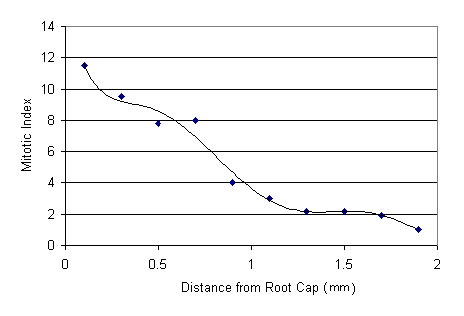
MITOTIC INDEX AND CELL DIVISION
Introduction: Cell population growth occurs as cells pass through interphase and mitosis to complete the cell cycle. Many cells lose the capacity to divide as they mature or divide only rarely. Other cells are capable of rapid cell division. For example, as plant roots grow, cells near the tip of the root, in the apical meristem, divide rapidly to push the root through the soil. The root cap detects the pull of gravity and directs the rapid growth of cells near the tip.
Importance: By quantifying aspects of a dividing cell population, we can examine how cells differ in their capability to divide. Experimentally, we can change properties of the cell's environment and quantify the effects on cell division.
Question: How do dynamics of cell division change among neighboring cells in a plant root? How does gravity affect cell division in plant roots?
Methods: For a group of cells that rarely complete the cell cycle, we expect a high proportion of cells to be in the resting stage of the cell cycle (G1). However, in a rapidly dividing cell population, we expect a high proportion of cells to be in the stage of mitosis. One way to quantify cell division is by using the mitotic index:

For example, the mitotic index can be used to examine cell proliferation in primary root tissue. The number of cells in mitosis were counted for cells from different regions of the primary root tissue.

Interpretation: In general, the mitotic index decreases with increasing distance from the root cap junction. Cells of the root cap protect the root and must be constantly replaced as they are damaged or scraped away. The apical meristem, just beneath the root cap, contains most of the root's dividing cells. Therefore, cells in this area must complete the cell cycle often. Some daughter cells become part of the root cap, others differentiate and elongate into primary tissues of the root. If we allow growing roots to take up a radioactive precursor of DNA, almost all of the labelled cells lie in the meristem.
The mitotic index can also be used to quantify differences in cell division when an environmental parameter is changed. Plants grown in space in microgravity had a greater mitotic index than control plants grown on the ground. In zero-gravity, the gravity sensing cells in the root cap are unable to send the proper orientation signals. These signals normally inhibit growth in cells that are more distant from the root cap junction, and direct elongation of the primary root. In the absence of these signals, cells begin dividing to produce secondary roots, leading to a greater number of cells in mitosis.
Conclusion: By quantifying properties of cell division, we can compare differences in cell growth among neighboring cells and in response to environmental variables.
Additional Questions:
1. Plot the mitotic index as a function of cell age for a population of cells that gradually lose the capacity to divide as they mature.
Source: Darbelley, N., D. Driss-Ecole, and G. Perbal. 1989. Elongation and mitotic activity of cortical cells in lentil roots grown in microgravity. Plant Physiological Biochemistry 27:341-347
Driss-Ecole, D., D. Schoevaert, M. Noin, and G. Perbal. 1994. Densitometric analysis of nuclear DNA content in lentil roots grown in space. The Cell 81:59-64.
Copyright 1999 M. Beals, L. Gross, S. Harrell